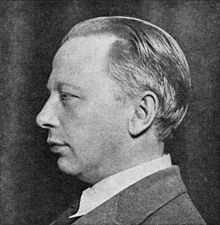Kurt Atterberg: Difference between revisions
Grungedude22 (talk | contribs) |
Grungedude22 (talk | contribs) |
||
| Line 16: | Line 16: | ||
As had [[Beethoven]] and [[Antonín Dvořák]], Atterberg composed nine symphonies. His last symphony, composed in 1956, features soloists and chorus. On February 22, 2005, CPO Records released a boxed set of recordings of all the symphonies, with Finnish conductor [[Ari Rasilainen]] (born 1959) conducting four different German orchestras.<ref>http://www.amazon.com/Kurt-Atterberg-Symphonies-Box-Set/dp/B0007ACVDW</ref> |
As had [[Beethoven]] and [[Antonín Dvořák]], Atterberg composed nine symphonies. His last symphony, composed in 1956, features soloists and chorus. On February 22, 2005, CPO Records released a boxed set of recordings of all the symphonies, with Finnish conductor [[Ari Rasilainen]] (born 1959) conducting four different German orchestras.<ref>http://www.amazon.com/Kurt-Atterberg-Symphonies-Box-Set/dp/B0007ACVDW</ref> |
||
Atterberg died in Stockholm on 15 February 1974. He is buried there in Norra Begravningsplatsen, the "Northern Cemetery". |
Atterberg died in Stockholm on 15 February 1974. He is buried there in [[Norra Begravningsplatsen]], the "Northern Cemetery". |
||
==See also== |
==See also== |
||
Revision as of 17:08, 4 March 2012

Kurt Magnus Atterberg (12 December 1887–15 February 1974) was a Swedish composer. He is best known for his symphonies, operas and ballets. Atterberg stated that "the Russians, Brahms and Reger were [his] ideals." His music combines their influences with Swedish folk tunes.
Biography
Atterberg was born in Gothenburg as the son of the engineer Anders Johan Atterberg (1845-1926) and nephew of chemist Albert Atterberg. He studied cello and would later occasionally play the cello in orchestras. He published his first work, a Rhapsody for Piano and Orchestra, Op. 1, in 1908. In 1910, he sent the Rhapsody and an incomplete version of the Symphony No. 1 in B minor, soon published as Op. 3, to the Stockholm Conservatory for admission. He studied composition and orchestration with Andreas Hallén there while simultaneously receiving instruction at the Royal Institute of Technology, earning a masters' degree in engineering in 1911.
From 1912 to 1968 Atterberg worked at the Swedish Patent and Registration Office, becoming head of a division there in 1937. In 1912, he made his conducting debut conducting his own Symphony No. 1. In 1916, he was appointed to Maestro of the Royal Dramatic Theatre in Stockholm, a position he held until 1922. His Violin Concerto in E minor, Op. 7 was premiered by the Australian violinist Alma Moodie on 6 November 1919, with the Berlin Philharmonic Orchestra under Max von Schillings.[1] From 1919 to 1957, he was a music critic for the Stockholmstidningen.
In 1924, Atterberg helped found the Society of Swedish Composers and the Swedish Performing Rights Society (an organization similar to ASCAP in America). In 1926 he became a member of the Royal Swedish Academy of Music and was secretary of that organization from 1940 to 1953.
While composing an opera about the Vikings, Härvard Harpolekare, Atterberg also wrote a "Sinfonia Piccola" (Symphony No. 4 in G minor, Op. 14) inspired by an anthology of Swedish folk tunes published in 1875.
For the Schubert centenary in 1928, the Columbia Gramophone Company sponsored a competition for a symphony completing or inspired by Schubert's "Unfinished" Symphony, and Atterberg won the first prize of $10,000 with his Symphony No. 6. The symphony was recorded by Sir Thomas Beecham in 1928 and Arturo Toscanini on November 21, 1943, (during an NBC Symphony Orchestra broadcast concert). Atterberg himself also conducted the Berlin Philharmonic Orchestra in a recording of the symphony, which was released on 78-rpm discs. He praised Toscanini's performance when he heard the recorded broadcast.[2]
As had Beethoven and Antonín Dvořák, Atterberg composed nine symphonies. His last symphony, composed in 1956, features soloists and chorus. On February 22, 2005, CPO Records released a boxed set of recordings of all the symphonies, with Finnish conductor Ari Rasilainen (born 1959) conducting four different German orchestras.[3]
Atterberg died in Stockholm on 15 February 1974. He is buried there in Norra Begravningsplatsen, the "Northern Cemetery".
See also
References
- ^ Kay Dreyfus, Alma Moodie and the Landscape of Giftedness, 2002
- ^ http://books.google.com/books?id=wBD_ujAW520C&pg=PA117&lpg=PA117&dq=Kurt+Atterberg,+Toscanini,+Mortimer+Frank&source=bl&ots=L7VLc_TCbX&sig=20kGEpQCXIgpcVdLjKAvkovh1oE&hl=en&ei=AetaTPSWFsP58Ab_25XbAg&sa=X&oi=book_result&ct=result&resnum=1&ved=0CAYQ6AEwAA#v=onepage&q&f=false
- ^ http://www.amazon.com/Kurt-Atterberg-Symphonies-Box-Set/dp/B0007ACVDW
External links
- Kurt Atterberg at Find-A-Grave
- Free scores by Kurt Atterberg at the International Music Score Library Project (IMSLP)
- Article on Atterberg's Third Symphony (Accessed 17 May 2011)
